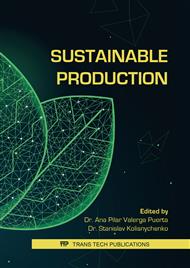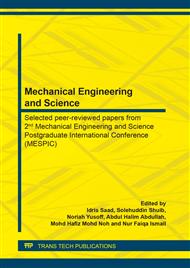[1]
S.-H. Ahn, D.-M. Chun and W.-S. Chu, Perspective to Green Manufacturing and Applications,, International Journal of Precision Engineering and Manufacturing, vol. 14, no. 6, pp.873-874, (2013).
DOI: 10.1007/s12541-013-0114-y
Google Scholar
[2]
T. W. Thurner and V. Roud, Greening strategies in Russia's manufacturing from compliance to opportunity,, Journal of Cleaner Production (Elsevier), pp.2851-2860, (2016).
DOI: 10.1016/j.jclepro.2015.09.126
Google Scholar
[3]
V. Albino, A. Balice and R. M. Dangelico, Environmental strategies and green product development: an overview on sustainability‐driven companies,, Business Strategy and the Environment, vol. 18, no. 2, pp.83-96, (2009).
DOI: 10.1002/bse.638
Google Scholar
[4]
A. S, R. Alvarez and R. Domingo, Model of efficient and sustainable improvements in a lean production system through processes of environmental provements,, Journal of Cleaner Production, vol. 47, pp.141-148, (2013).
DOI: 10.1016/j.jclepro.2012.11.048
Google Scholar
[5]
N. b. Yusoff, A. Farooqi, O. Al-Sultan, A. R. A.Alnasser and M. Bhuiyan, A Strategic Development of Green Manufacturing Index (GMI) Topology Concerning the Environmental Impacts,, Procedia Engineering, vol. 184, pp.370-380, (2017).
DOI: 10.1016/j.proeng.2017.04.107
Google Scholar
[6]
H. El-Hofy, Advanced Machining Processes, USA: The McGraw-Hill Companies, (2005).
Google Scholar
[7]
P. Sreejith and B. Ngoi, Dry machining: Machining of the future,, Journal of Materials Processing Technology, vol. 101, no. 1-3, pp.287-291, (2000).
DOI: 10.1016/s0924-0136(00)00445-3
Google Scholar
[8]
D. P. Adler, W. W.-S. Hii, D. J. Michalek and J. W. Sutherland, Examining the role of cutting fluids in machining and efforts to address associated environmental/health concerns,, International Journal of Machining Science and Technology, vol. 10, no. 1, pp.23-58, (2006).
DOI: 10.1080/10910340500534282
Google Scholar
[9]
F. Klocke and G. Eisenblätter, Dry Cutting,, CIRP Annals, vol. 46, no. 2, pp.519-526, (1997).
DOI: 10.1016/s0007-8506(07)60877-4
Google Scholar
[10]
K. K. Gajrani, S. Suresh and M. R. Sankar, Environmental friendly hard machining performance of uncoated and MoS2 coated mechanical micro-textured tungsten carbide cutting tools,, Tribology International, vol. 125, pp.141-155, (2018).
DOI: 10.1016/j.triboint.2018.04.031
Google Scholar
[11]
S. A. Lawal, I. A. Choudhury and Y. Nukman, A Critical Assessment of Lubrication Techniques in Machining Processes: A Case for Minimum Quantity Lubrication Using Vegetable Oil-Based Lubricant,, Journal of Cleaner Production, vol. 41, pp.210-221, (2013).
DOI: 10.1016/j.jclepro.2012.10.016
Google Scholar
[12]
Davim and J. Paulo, Machining: Fundamentals and Recent Advances, London: Springer-Verlag, (2008).
Google Scholar
[13]
J. A. McGeough, Micromachining of Engineering Materials, New York: Marcel Dekker, Inc., (2002).
Google Scholar
[14]
A. Samant, Laser Machining of Structural Ceramics: Computational and Experimental Analysis (PhD dissertation),, University of Tennessee, Knoxville, (2009).
Google Scholar
[15]
T. Sugihara, P. Singh and T. Enomoto, Development of novel cutting tools with dimple textured surfaces for dry machining of aluminum alloys,, Procedia Manufacturing, vol. 14, pp.111-117, (2017).
DOI: 10.1016/j.promfg.2017.11.013
Google Scholar
[16]
S. P. Lerato Criscelda Tshabalala, Surface texturing of Si3N4-SiC ceramic tool components by pulsed laser machining,, Surface and Coating Technology, vol. 289, pp.52-60, (2016).
DOI: 10.1016/j.surfcoat.2016.01.028
Google Scholar
[17]
C. Gachot, A.Rosenkranz, S.M. Hsu and H.L. Costa, A critical assessment of surface texturing for friction and wear improvement,, Wear, vol. 372 – 373, pp.21-41, (2017).
DOI: 10.1016/j.wear.2016.11.020
Google Scholar
[18]
S.Niketh and G.L. Samuel, Surface texturing for tribology enhancement and its application on drill tool for the sustainable machining of titanium alloy,, Journal of Cleaner Production, vol. 167, pp.253-270, (2017).
DOI: 10.1016/j.jclepro.2017.08.178
Google Scholar
[19]
I. P. Girsang and J. S. Dhupia, Machine Tools for Machining,, in Handbook of Manufacturing Engineering and Technology, London, Springer, 2015, pp.811-865.
DOI: 10.1007/978-1-4471-4670-4_4
Google Scholar
[20]
Y. Altintas, A. Verl, C. Brecher, L. Uriarte and G.Pritschow, Machine tool feed drives,, CIRP Annals, vol. 60, no. 2, pp.779-796, (2011).
DOI: 10.1016/j.cirp.2011.05.010
Google Scholar
[21]
Deutsche Gesetzliche Unfallversicherung (DGUV), Minimum quantity lubrication for machining operations (BGI/GUV-I 718 E),, Deutsche Gesetzliche Unfallversicherung (DGUV), Berlin, (2010).
DOI: 10.17147/asu-2004-8389
Google Scholar
[22]
T. Singh, P. Singh, M. Dogra, H. Singh and M. S. Bhatti, A review of near dry machining/minimum quantity lubrication machining of difficult to machine alloys,, International Journal of Machining and Machinability of Materials, vol. 18, no. 3, pp.213-251, (2016).
DOI: 10.1504/ijmmm.2016.076276
Google Scholar
[23]
A. Attanasio, M. Gelfi, C. Giardini and C. Remino, Minimal quantity lubrication in turning: Effect on tool wear,, Wear, vol. 260, pp.333-338, (2006).
DOI: 10.1016/j.wear.2005.04.024
Google Scholar
[24]
M. P. M. A. A. S. RR Srikant and P. V. Krishna, Nanofluids as a potential solution for Minimum Quantity Lubrication: A review,, Journal of Engineering Manufacture, pp.1-18, (2016).
Google Scholar
[25]
P.-H. Lee, T. S. Nam, C. Li and S. W. Lee, Environmentally-Friendly Nano-fluid Minimum Quantity Lubrication (MQL) Meso-scale Grinding Process Using Nano-diamond Particles,, International Conference on Manufacturing Automation, vol.
DOI: 10.1109/icma.2010.27
Google Scholar
[26]
A. Arslan, H. H. Masjuki, M. A. Kalam, M. Varman, R. A. Mufti, M. H. Mosarof, L. S. Khuong and M. M. Quazi, Surface Texture Manufacturing Techniques and Tribological Effect of Surface Texturing on Cutting Tool Performance: A Review,, Journal of Critical Reviews in Solid State and Materials Sciences , vol. 41, no. 6, pp.447-481, (2016).
DOI: 10.1080/10408436.2016.1186597
Google Scholar
[27]
I. Etsion, Modeling of surface texturing in hydrodynamic lubrication,, Friction, vol. 1, no. 3, pp.195-209, (2013).
DOI: 10.1007/s40544-013-0018-y
Google Scholar
[28]
S. Sheu, L. G. Hector and O. Richmond, Tool Surface Topographies for Controlling Friction and Wear in Metal-Forming Processes,, Journal of Tribology, vol. 120, no. 3, pp.517-527, (1998).
DOI: 10.1115/1.2834581
Google Scholar
[29]
A. Ronen, I. Etsion and Y. Kligerman, Friction-Reducing Surface-Texturing in Reciprocating Automotive Components,, Journal of Tribology Transactions, vol. 44, no. 3, pp.359-366, (2001).
DOI: 10.1080/10402000108982468
Google Scholar
[30]
F. Mücklich, A. Lasagnia and C. Daniel, Laser Interference Metallurgy – using interference as a tool for micro/nano structuring,, International Journal of Materials Research, vol. 97, no. 10, pp.1337-1344, (2006).
DOI: 10.3139/146.101375
Google Scholar



